(January 1928, 20m) Director: E. Livingston Kennedy Released: MGM, April 21, 1928 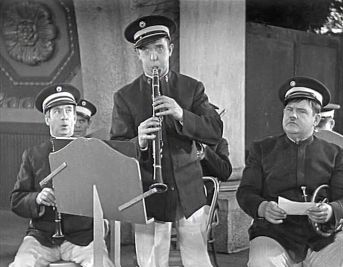 In 2006 the comedian Paul Merton presented a BBC series known as Silent Clowns, where the works of Chaplin, Keaton and Lloyd were looked back upon. The third episode aired in June and was dedicated to Laurel and Hardy, focussing on this particular short, the centrepiece being a new orchestral score to the movie. Composed by the writer Neil Brand (who had written the radio play Stan two years earlier, based on the final days of the duo), it offered a more synchronised take on the picture, individual instruments specifically selected to match those onscreen, rather than the general ambient mix usually placed with it on its DVD releases. Filmed under the working title 'The Music Blasters', a title with which it was released in England, You're Darn Tootin' is innovative as it's a silent clearly set to a beat. However, you may find it's more a short you'll admire rather than love.    (February 1928, 22m) Director: James Parrott Released: MGM, May 19, 1928 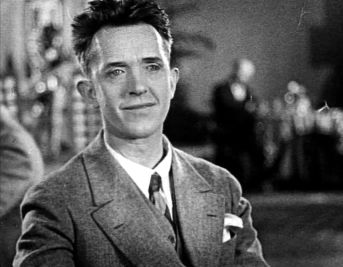 Their Purple Moment is an example of a single idea taken to its logical extreme for maximum comic value: what if Stan took Ollie out to dinner and ran up a large bill, only to find his wife had replaced all his money with worthless tokens? The first Laurel and Hardy film to feature both lead characters married (though Stan's character here is named 'Mr. Pincher', a sign that they hadn't quite got accustomed to using their real names as a regular fixture) with both under the stern control of domineering spouses. This is also the Laurel and Hardy film where we get the first real glimpse of Hardy's tattoo. A maple leaf design on his right arm, Hardy had the tattoo done when he was just fourteen years of age, much to the chagrin of his mother. It can be briefly glimpsed in the Pink Pup, whereas normally, as with Flying Elephants, it would be covered with make up.     (March 1928, 20m) Director: James Parrott Released: MGM, September 8, 1928 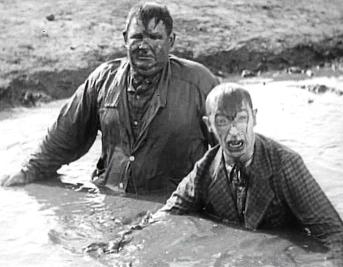 An interesting example in how Laurel and Hardy's comedy evolved, Should Married Men Go Home? ends in a tenuously-connected mud fight, and can seem somewhat 'retro' in its scope, even for the time. Yet despite the relatively uninspired conclusion, there's plenty of fresh comedy here that gets honed and reused in their later career: just a year later and they were reworking the soda fountain scene (Ollie offers to buy two women and Stan a drink to impress them but can't afford Stan's so requires Stan to refuse, much to Stan's confusion) in Men O'War. Forward three years and the inspired visual gag of Ollie pretending not to be home and Stan leaving a note - only to see Ollie snatch the note from under the door - was given another outing in Come Clean. Yet also an addition to their canon is Hardy's attempt to one-up Stan in terms of trivial games and feats. Their Purple Moment had given us Ollie trying to impress girls by doing Stan's 'flipping a spoon into a glass' trick better than Stan... with disastrous results. Here, aware his wife is watching, he tries to impress her by leaping over his gate the way he's seen Stan do... only to crush the entire fence. This was a semi-regular fixture that we would see again over the years, particularly in their features, notably Fra Diavolo. Hal Roach and Oliver Hardy were both avid golfers, Hardy particularly after being introduced to the sport by Larry Semon. With this in mind it's surprising that the sport was never used again for a Laurel and Hardy short, this its isolated appearance in their work. Most notable about Should Married Men Go Home? is that, while Laurel and Hardy as a team had been a fixture in the Roach studios for some time, this was the first one no longer produced under the 'All Star' banner.    (May 1928, 18m) Director: Emmett Flynn Released: MGM, October 6, 1928 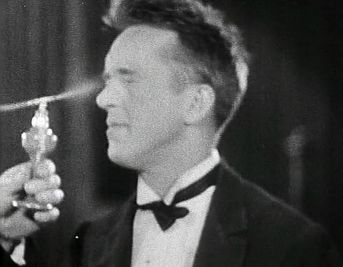 The only Laurel and Hardy picture other than Brats to feature no other actors apart from the two leads, Early To Bed sees Ollie inherent a fortune from his deceased uncle. Probably the most atypical of the 'in character' Laurel and Hardy movies, this sudden reversal of fortunes causes Hardy to become mischievous and carefree, but with a malicious edge. Absorbing as a drama, it's nevertheless hard to laugh at the wilful upset that Hardy causes Stan throughout. At one point Stan gets a throat spray poured into his eyes, and when he cries in this film it's not a comic cry but a real one. A particularly unsettling moment sees Hardy (via title card) complain about a woman he'd met offscreen, her only fault being that 'she's Chinese'. It's an unusual moment of edge in the normally softer world that the duo inhabit. It's as if the viewer has entered some bizarre parallel universe where Hardy turned bad, a look at a sideways world where if their circumstances were different then their lives would take a turn for the worse. In this regard it perhaps acts as a warning... be careful what you wish for. On the other hand, it could just be a throwaway short they knocked together in a couple of weeks and I'm taking it way too seriously.    (June/July 1928, 21m) Director: James Parrott Released: MGM, November 3, 1928 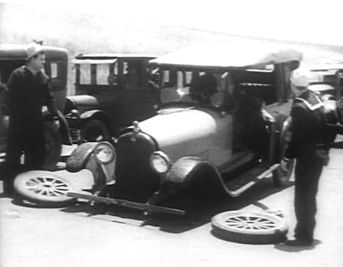 An expansion of the 'reciprocal destruction' style of comedy first seen in Leave 'Em Laughing, Two Tars is one of their funniest and most OTT silents, even if it perhaps lacks enough character to reward repeat viewings. Reputedly a deleted third reel was made for preview copies, bearing the title 'Two Tough Tars'.     (July 1928, 20m) Director: James Parrott Released: MGM, December 1, 1928 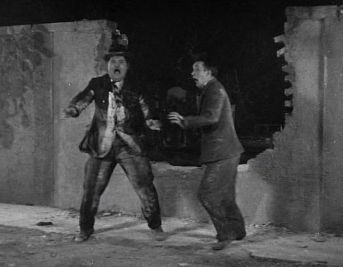 It's surprising that in the development of the Laurel and Hardy characters they often did jobs that would be unsympathetic to the audience. In Bacon Grabbers they're bailiffs, whereas here they're offered $500 (over $6000 in today's climate) by a mad professor to grave rob dead bodies. Despite the witty title (habeas corpus ad subjiciendum, Latin for 'You [shall] have the body to be subjected to [examination]') this is a somewhat flat and uninspired short, featuring lots of uncharacteristic overacting from the two leads. Perhaps most damning is that it's the fifth short to feature a 'characters falling down a previously unseen mud hole' as a pay-off. One of the better gags - Ollie tries to give Stan a 'leg up' over a wall, only for Stan to completely misunderstand his role in the act - was reused in Berth Marks nine months later. The Hal Roach Laurel and Hardy shorts were largely filmed in chronological order, which was extremely rare for film. However, evidence that this was not the case for Habeas Corpus can be witnessed with the first scene where Stan and Ollie ring the Professor's doorbell... the white paint on Ollie's sleeve that he would later get in the short is present. Another point of trivia is that although Oliver Hardy is often referred to onscreen and on this site as 'Ollie', his offscreen nickname was 'Babe'. As the actor himself related in a 1950 interview with Jack Mangan he got the name 'years and years ago when I had my first shave. So the barber went in and he charged a dime and he put some powder [on] and he said "that's alright, baby, you're clean." That name has stuck ever since.' Stan can often be seen calling Hardy by this nickname in the silent shorts, most notably here and in Big Business. Although officially credited to James Parrott, some sources claim that this was the first Laurel and Hardy film to be directed by supervisor Leo McCarey.   (August/September 1928, 20m) Director: Leo McCarey Released: MGM, December 29, 1928 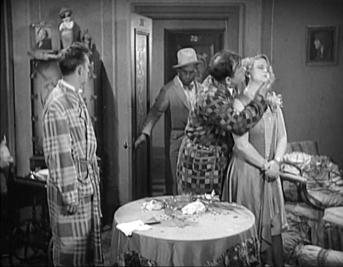 An influential two-reeler, the basis of which - Stan and Ollie lie to their wives about going for a drunken night out, only to be discovered - went on to form the basis of Sons of the Desert, one of their most popular films. Not only that but the final payoff was reworked for Block-Heads. Stan is notably more intelligent than his usual persona here, and also more callous, giving a reason for not liking a girl as 'she's too fat!' The biggest talking point of the short though is that it was the first to be directed by Leo McCarey, the man who went on to direct the 1933 Marx Brothers classic Duck Soup. McCarey had worked with the Hal Roach studios since 1923 and was promoted to supervising director of all Roach comedies in 1926. As a result he'd overseen every Laurel and Hardy movie since Hats Off and is still commonly regarded as the man who first came up with the idea of making Stan and Ollie a proper pairing. Though this site rightly highlights Stan's involvement in the Laurel and Hardy output, McCarey's must not be overlooked, often devising entire plots for the shorts, such as Wrong Again. Many of the Laurel and Hardy titles, such as Hog Wild and Beau Hunks, didn't translate over to England, and so We Faw Down - 1920s American baby talk slang - was released in Britain under the name 'We Slip Up'.    (September/October 1928, 20m) Director: Leo McCarey Released: MGM, January 26, 1929 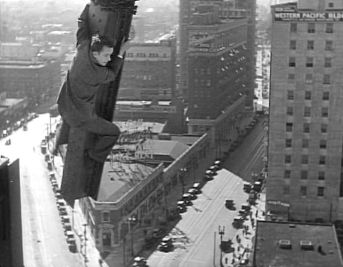 Many of Laurel and Hardy's fans like to insist upon their heroes being innocent entertainment, and any double meanings in their films purely unintentional. While Stan and Ollie did become progressively more family friendly, the sly innuendo that creeps into many of their silent shorts adds a completely different dimension to their comedy, and to deny its existence seems to deny the very point of the shorts themselves. Liberty is probably the most subversive Laurel and Hardy film of all time, opening with a series of images that contrast America's quest for liberty with two escaped criminals fleeing from jail. As if this wasn't enough for 1929 audiences when the film was released, we have the entire first act centred around their dilemma: in changing out of their prison clothes they've put on the wrong trousers. The first reel features the duo hiding in various locations attempting to swap trousers, with the reaction of all passer-bys that they're witnessing a homosexual act in progress. The projected innocence comes from Laurel and Hardy, who play the roles with no conception of the misimpression they're giving, but the joke itself comes from the outraged expressions and suspicions of those around them. While Laurel and Hardy themselves are innocent of the act, the belief by secondary characters that they're not is what makes the gag. An extremely contentious issue for many admirers of Laurel and Hardy, the idea that Stan and Ollie would try and get laughs from sexual allusion, especially same sex pairings, is one that conjures up instant defensive declarations that the duo were never portrayed as gay, especially in a landscape where such activities were still illegal. However, Stan and Ollie being gay is not the issue, only that laughs were generated from them occasionally unwittingly indulging in gay behaviour, or behaviour that could be perceived to be gay by those around them. Even into the late 30s Stan was getting easy laughs from kissing Ollie on the mouth (again, to make this clear, the implication isn't that Laurel and Hardy were homosexual lovers, merely that Stan in real life knew that two men kissing was a sure laugh-getter back in the 30s), while in That's My Wife an entire room full of people are under the mistaken belief that Ollie is attempting to copulate with Stan in drag. In fact, the final Laurel and Hardy film in 1950, Atoll K, sees Stan giving Ollie a peck on the cheek, thinking that he's a woman they're all chasing. Stan's intent is to kiss a girl... but the laugh comes from the sight of Stan kissing another man. No 'agendas' or 'hidden subtexts'... just pure music hall tradition. Their First Mistake, a later sound film, plays with gender role conventions, getting laughs out of Ollie being the metaphorical wife to Stan's dismissive husband. This gag would be reprised many times, with Ollie wearing aprons while Stan left the house to do work (Pack Up Your Troubles) and, when prompted if he's forgotten something, Stan unthinkingly does the 'dutiful husband' routine and gives Ollie a peck on the cheek in The Bohemian Girl. It's almost as if the Disneyfied antics of such films as The Chimp and Babes In Toyland have retroactively rewritten Laurel and Hardy's personal catalogue into them being a purely innocent, 'for-all-the-family' duo where the concept of sex - even if it's one of Hardy's many shrewish screen wives suspecting him of having an extra-marital affair - is entirely non-existent. Yet such assertions over the content of their back catalogue seem to dismiss whole swathes of sly humour, and overlook such explicit divergences as a prostitute roaming the hallways in Angora Love. Laurel and Hardy may have become a favourite amongst children, but that time was some way off yet, and the silent age, as we've seen, was one where Stan would dress as a woman to lure sailors to their doom with the promise of sexual fulfilment (Why Girls Love Sailors). By the time Liberty was made, Harold Lloyd was the biggest box office star in the world, overtaking Chaplin largely by the quantity of his output. Although he had parted ways with Hal Roach some four years previously, the two had worked together for many years and it was Roach that was the producer and co-writer of Lloyd's most famous film, the 1923 classic Safety Last! The form of 'thrill comedy' that Lloyd introduced by scaling a building is reproduced here, with Stan and Ollie spending the second reel on top of a city-scaling construction site. The natural assumption today is that two bankable stars would be standing in front of a back projection, or some form of camera trickery would be involved. While Stan and Ollie were not quite Keatonesque, breaking all their bones in the name of art, the reality that they were on a three-storey construction built on top of a 150 foot building is still mind-blowing today. A safety net was used, but broke, increasing the sense of real danger. The short ends with some body horror comedy as a policeman is crushed by their antics, emerging from a lift shaft as a midget. As we'll see in future shorts, Stan had something of a minor fixation with body horror in his comedy, and it led to some unusual endings. A notable point of trivia is that the blonde lady that tries to enter the cab before Stan and Ollie get out of it was a 17-year-old Jean Harlow. Harlow would again appear with the boys - first as a high-class blonde in Double Whoopee and later as Edgar Kennedy's wife in Bacon Grabbers. Harlow would later go on to be a megastar, and in 1999 was voted the 22nd greatest female movie star of all time by the American Film Institute. Harlow died in June 1937, at a time when Stan and Ollie's career was about to enter a major decline. All of this lay some years into the future, however, and there were many more laughs to come. For Liberty, it remains for me the finest silent they ever did, and one of their finest films of all.      (October/November 1928, 20m) Director: Leo McCarey Released: MGM, February 23, 1929 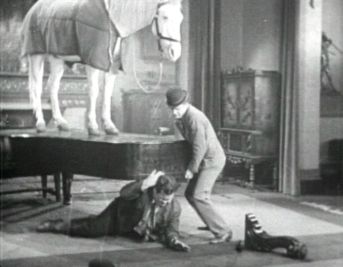 A string of misunderstandings lead Stan and Ollie to place a racehorse on top of a piano in a rich manor house. What's notable about these early Laurel and Hardy films is that the two leads often revel in their own mistakes and chaos... when caught in the act they don't show fear and remorse like later years would give us, but sheepish giggling at their own destruction. Wrong Again was heavily written by Leo McCarey, and was last Laurel and Hardy picture to be directed by him. In 1929 McCarey would leave the Roach studios and go on to be a double Oscar winner for his role in the film industry.    (December 1928, 20m) Director: Lloyd French Released: MGM, March 23, 1929 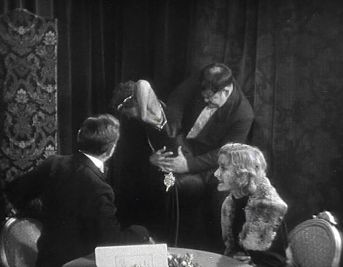 A hilarious reworking of a Glenn Tryon/Oliver Hardy short known as Along Came Auntie. The Auntie two-reeler was co-written by Stan in 1926 back when he was still in his retirement from acting stage. There the basic plot was a divorce-hating Auntie coming back to visit her niece, causing said niece to pretend she's still married to her first husband (Hardy) and getting her second husband (Tryon) to wear a dress in order to protect her future inheritance. Though faintly amusing, Tyron's lack of genuine screen presence fails to make Along Came Auntie really take off. Here the situation is inverted: Ollie is being visited by his Uncle, and, with his wife having left him, gets Stan to dress up in drag. One of their cheekiest films, what follows is a run of misunderstandings as a necklace drops down the back of Stan's dress, and when Ollie tries to retrieve it all witnesses at The Pink Pup think that something inappropriate is going on. Perhaps the most charming scene of all occurs right at the end, where Stan laughs at Ollie with a bowl of soup over his head, and, just before the fade out, Hardy begins to smile as if breaking out of character. A basic, broad laughs situation made into something quite superb, and probably one of the ten best shorts they ever did.     (December 1928, 19m) Director: James W. Horne Released: MGM, April 20, 1929 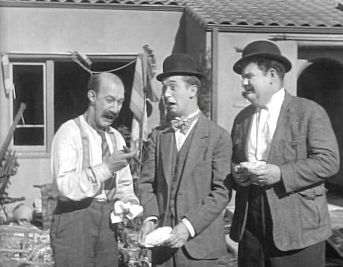 Lauded as one of Laurel and Hardy's finest films, Big Business takes the reciprocal destruction theme of Two Tars and reworks it in mutual chaos with the two boys and James Finlayson. Enjoyable stuff, though the Stan and Ollie here aren't Stan and Ollie as we'd later know them... as we saw in films like Wrong Again, here they bear no regret over their actions. A possibly apocryphal story surrounding Big Business concerned a tale of Hal Roach's, where he claimed the wrong house was demolished. 'That was a lot of baloney', said Stan in a telephone conversation in 1964, 'did he think we were a bunch of nuts or something? [...] He wasn't even in town when we made that picture.'    
| ||||||||||||||||||||||||||||||||||||||||||||||||||||||||||||||||||||||||